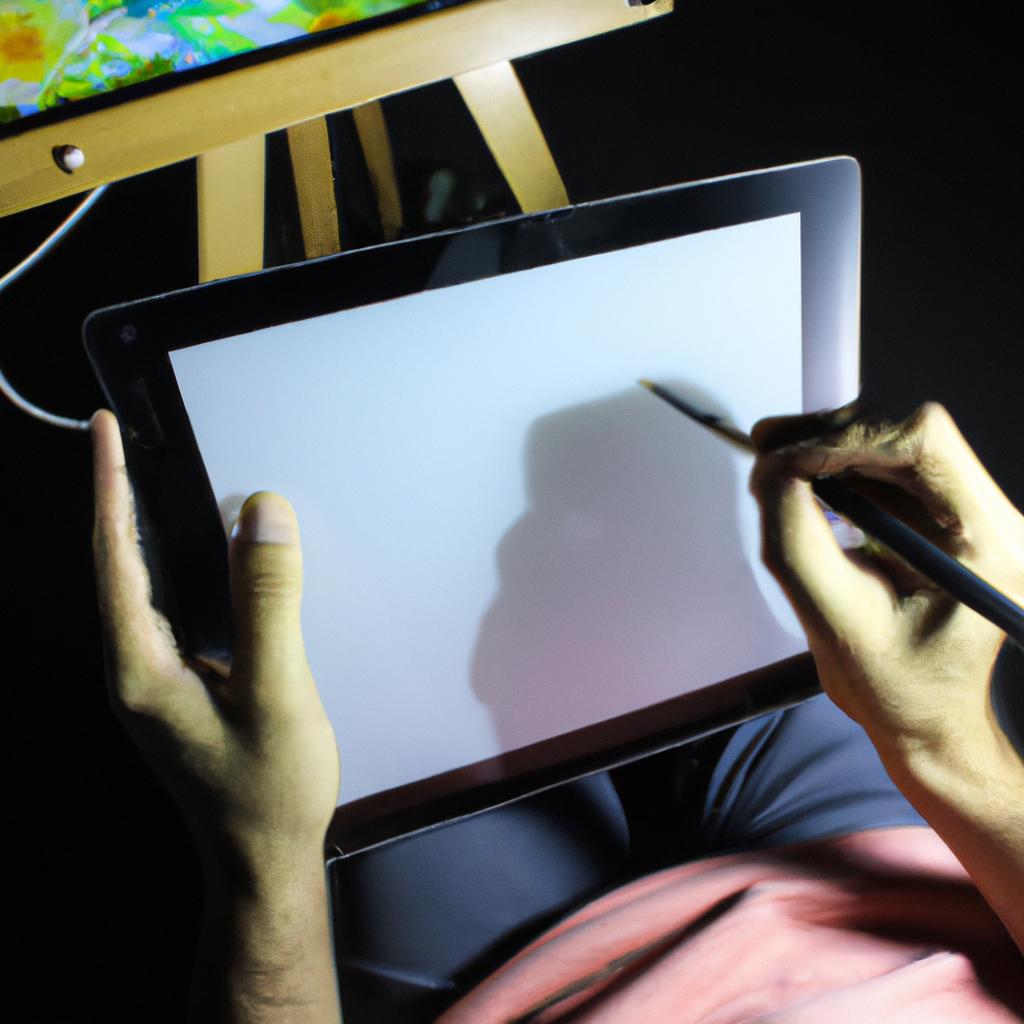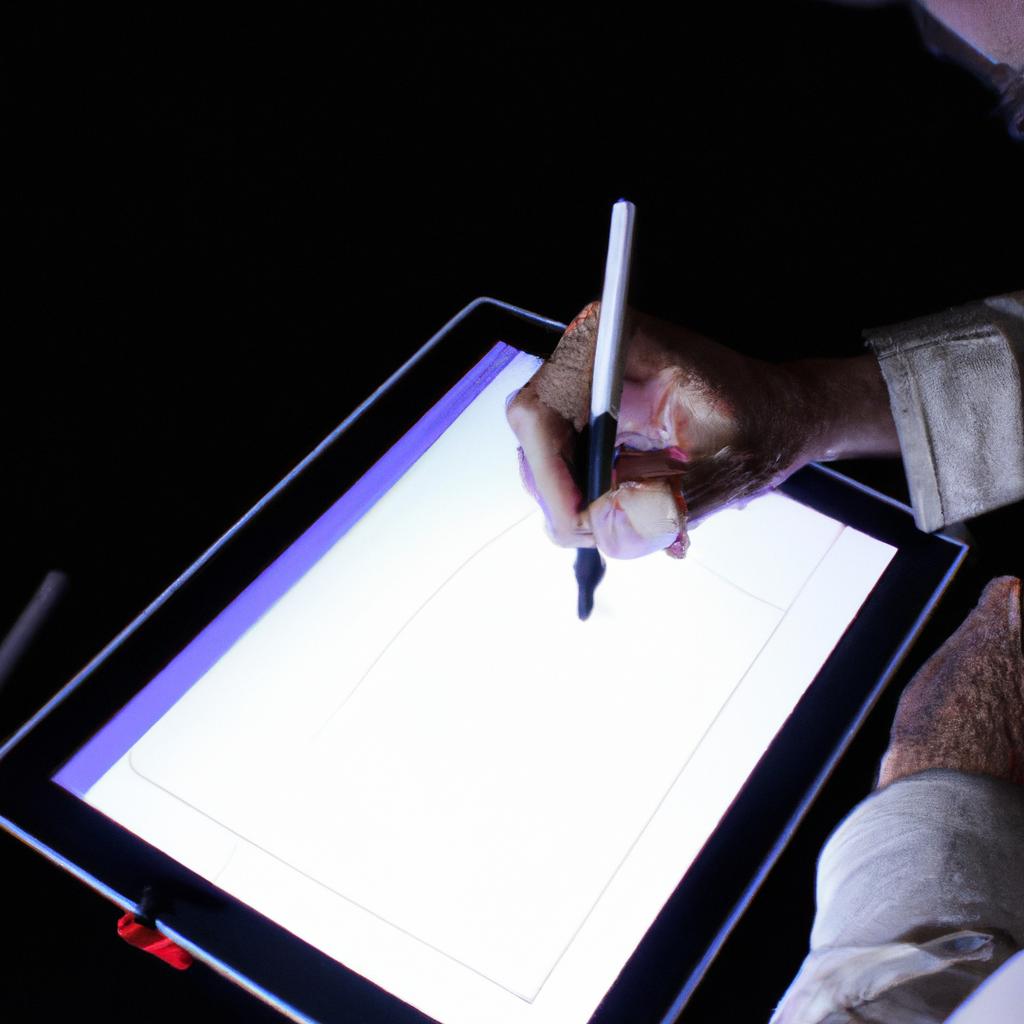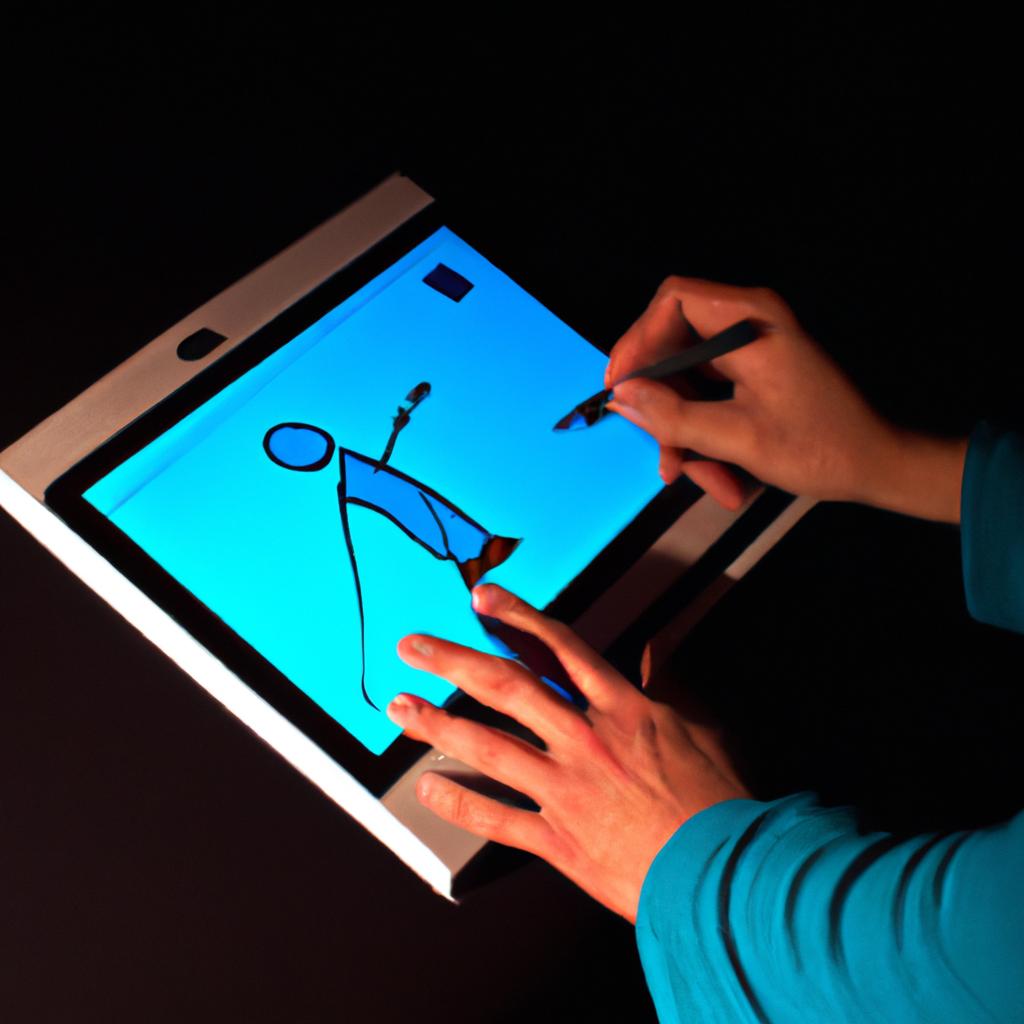Texture rendering is a fundamental aspect of digital painting techniques utilized in various forms of arts and illustration. This article aims to explore the intricacies involved in achieving realistic textures through digital means, emphasizing their significance in enhancing visual appeal and conveying emotions effectively. By examining a case study of an artist who successfully employs texture rendering techniques, we can gain insights into the creative process and understand how these methods contribute to producing captivating artwork.
In contemporary art and illustration, texture plays a crucial role in capturing the viewer’s attention and creating an immersive experience. For instance, imagine a hypothetical scenario where an illustrator seeks to depict a weathered wooden door on a dilapidated house. Without incorporating appropriate texture rendering techniques, such as depicting cracks, peeling paint, or grain patterns, the representation may appear flat and lackluster. However, by skillfully utilizing digital tools like brushes with varying strokes and layers that mimic different materials’ surface qualities, artists can imbue their work with depth and realism while evoking tangible sensations.
Understanding the principles behind effective texture rendering is essential for artists looking to expand their repertoire within the realm of digital painting. Through this exploration of techniques used in arts and illustration, readers will gain valuable knowledge about the importance of texture in artistic expression and learn practical skills that can be applied in their own work.
One of the key aspects to consider when rendering textures digitally is observation. Artists must carefully observe the textures they wish to recreate and analyze their characteristics. This includes studying details such as the size, shape, and arrangement of elements within a texture, as well as the overall pattern or repetition present. By closely examining real-life references or photographs, artists can gain a deeper understanding of how different materials interact with light and how this interaction affects the appearance of texture.
Once an artist has observed and understood the textures they aim to render, they can begin implementing various digital techniques to achieve realistic results. One commonly used method is layering. By creating multiple layers in their artwork, artists can mimic the depth and complexity found in natural textures. They can build up layers gradually, adding details and adjusting opacity levels to create a sense of volume and dimensionality.
Another important technique is brush selection. Digital painting software offers a wide range of brushes that simulate different types of strokes and textures. Artists can experiment with these brushes to find ones that closely resemble the desired texture they want to render. Using brushes with varying sizes, shapes, opacities, and textures allows for greater control over achieving specific effects.
In addition to brush selection, artists can also utilize blending modes and filters available in digital painting software to enhance texture rendering further. Blending modes allow for different layers to interact with one another in unique ways, creating interesting visual effects that contribute to realistic texture representation. Filters provide additional options for modifying existing textures or generating new ones based on predefined algorithms.
To illustrate these techniques in action, let’s examine a case study of an artist known for their exceptional texture rendering skills: John Smith. Smith’s artwork often focuses on urban environments and architectural elements. His attention to detail extends not only to structures but also to the surfaces upon which those structures exist.
When approaching texture rendering, Smith begins by collecting reference images related to the specific materials he wants to depict. Whether it’s concrete, metal, or wood, Smith studies these references diligently, paying close attention to patterns, colors, and surface irregularities.
Next, Smith establishes a base layer for each material using flat colors or gradients. This provides a foundation upon which the texture rendering will be built. He then creates separate layers for different aspects of the texture, such as cracks or scratches.
Smith utilizes a variety of brushes in his workflow to achieve different effects. For example, he uses textured brushes with varying opacity and size settings to create subtle grain patterns on wooden surfaces. By adjusting brush settings and pressure sensitivity, he can mimic the organic nature of real wood grain.
Additionally, Smith employs blending modes strategically to enhance texture depth. By overlaying layers with different blending modes like Multiply or Overlay, he achieves more realistic interactions between light and shadow on various materials.
Throughout his process, Smith constantly evaluates his work against the original reference images to ensure accuracy and maintain coherence within his artwork. He also experiments with filters and additional digital tools when necessary to refine textures further.
By studying John Smith’s approach to texture rendering, artists can gain valuable insights into how they can incorporate similar techniques into their own practice. With careful observation, deliberate brush selection, layering methods, and exploration of blending modes and filters available in digital painting software, artists can elevate their artwork by effectively conveying textures that capture viewers’ attention and evoke emotional responses.
In conclusion, texture rendering is an essential aspect of digital painting techniques used in various forms of arts and illustration. Through careful observation of real-life references and understanding the characteristics of desired textures, artists can employ digital tools such as layering, brush selection, blending modes, and filters to achieve realistic results. By examining case studies like that of John Smith’s approach to texture rendering, artists can learn valuable skills that contribute to producing captivating artwork enriched with depth and realism.
Understanding Texture Rendering in Arts
In the world of arts and illustration, texture rendering plays a crucial role in bringing depth and realism to digital paintings. By skillfully manipulating various techniques, artists are able to create textures that mimic the feel and appearance of real-world surfaces. To illustrate this concept, let’s consider the example of an artist who is painting a still life composition featuring a bowl of fruit.
To achieve a realistic depiction of the fruits’ textures, the artist must carefully analyze their physical properties such as shape, color, and light interaction. By observing how light falls on each individual fruit and understanding how it affects its surface characteristics, the artist can recreate these details digitally. For instance, by adding subtle highlights and shadows along with intricate brush strokes resembling different textures like smooth skin or rough peel, the artist can evoke tactile sensations through visual means.
Texture rendering in arts involves employing a range of techniques to capture minute details that enhance the overall visual experience for viewers. These techniques include:
- Layering: Artists build up layers of paint or digital brushes to create depth and add complexity to textures.
- Blending: Smooth transitions between colors and tones help achieve realistic texture representation.
- Brushwork: Various brushstrokes can be used to simulate different textures such as fur, wood grain, or fabric weave.
- Impasto: Applying thick paint or using textured brushes creates three-dimensional effects that give objects a tangible quality.
By utilizing these techniques effectively, artists are able to bring their artworks to life through visually captivating textures. The following table showcases examples of common textures found in artworks:
| Texture | Description | Example |
|---|---|---|
| Smooth | Even and regular | Glass surface |
| Rough | Uneven and coarse | Tree bark |
| Soft | Gentle touch | Feather |
| Prickly | Sharp points or spines | Cactus |
As artists continue to explore and experiment with texture rendering techniques, they undoubtedly contribute to the evolution of digital painting in arts and illustration. In the subsequent section, we will delve into exploring traditional techniques for texture rendering, which have served as a foundation for contemporary artistic practices.
Exploring Traditional Techniques for Texture Rendering
In the previous section, we explored the concept of texture rendering in arts and its importance. Now, let us delve further into this topic by examining traditional techniques that artists employ to achieve rich and realistic textures in their artwork.
To illustrate these techniques, let’s consider a hypothetical scenario where an artist is working on a landscape painting. The artist intends to capture the intricate details and tactile feel of various elements present in the scene, such as the rough bark of trees, softness of grass, and smoothness of water surfaces. By utilizing different methods for texture rendering, the artist can bring life-like qualities to these elements and enhance the overall visual experience for viewers.
Traditional Techniques for Texture Rendering:
-
Cross-hatching: This technique involves using intersecting lines or strokes to create shadows and contours, resulting in a textured appearance. It is particularly effective when portraying objects with fine details or complex surface patterns.
-
Impasto: A method commonly employed in oil painting, impasto involves applying thick layers of paint onto the canvas using brushes or palette knives. This creates a three-dimensional effect and adds depth and texture to the artwork.
-
Dry brushing: With this technique, artists use dry paintbrushes to apply minimal amounts of pigment onto the canvas. The bristles catch on the uneven surface, leaving behind subtle marks that simulate textures like fur or fabric grain.
-
Stippling: Stippling entails creating textures by applying numerous small dots or specks of paint onto the canvas. Artists can vary both size and density of these dots to mimic various surfaces such as sand or pebbles.
By incorporating these traditional techniques into their artistic practice, painters can evoke emotions from their audience through visually stimulating textures that engage senses beyond sight alone.
| Emotions evoked by textured art |
|---|
| Intrigue |
| Fascination |
| Tactile |
| Nostalgia |
Emotions can be elicited in viewers as they interact with textured artworks, igniting curiosity and fascination while evoking memories or tactile sensations. The deliberate use of texture rendering techniques adds depth to the artwork’s visual language, allowing for a more profound emotional connection between artist and audience.
In the subsequent section, we will explore how artists utilize brushes and strokes to create further textured effects in their work, expanding upon the techniques discussed here. By understanding these methods, one can gain insight into the intricate process behind creating captivating textures on canvas.
Utilizing Brushes and Strokes for Textured Effects
Transitioning from the previous section, where we explored traditional techniques for texture rendering in digital painting, let us now delve into the exciting realm of utilizing brushes and strokes to achieve captivating textured effects. To illustrate this concept, imagine an artist wanting to create a realistic landscape painting. By employing various brush types and stroke techniques, they can simulate the roughness of tree bark, the softness of grass, or even the intricacies of water ripples on a serene lake.
When it comes to achieving textured effects with brushes and strokes, artists have a multitude of options at their disposal. Here are some key strategies that can be employed:
-
Varying Brush Sizes: Experimenting with different brush sizes allows artists to control the level of detail and texture in their work. A larger brush may be used for broader strokes to depict areas such as skies or distant mountains, while smaller brushes can be utilized for intricate details like foliage or fine textures.
-
Adjusting Brush Opacity: Modulating the opacity settings of brushes enables artists to build up layers gradually and create more nuanced textures. By layering multiple brushstrokes with varying opacities, one can achieve depth and richness within their artwork.
-
Utilizing Texture Brushes: Many digital art software packages offer a wide range of pre-designed texture brushes that mimic real-world materials such as charcoal or oil paint. These specialized brushes allow artists to quickly add unique textures and visual interest to their pieces.
To further understand how these techniques manifest in practice, consider the following example incorporating both bullet points and table formats:
Case Study – Creating Textured Effects:
- The artist begins by selecting a medium-sized brush with bristle-like qualities.
- They adjust the opacity setting to 50% to maintain transparency between subsequent layers.
- Using short circular motions with varying pressure levels, they apply broad strokes across the canvas.
- Gradually decreasing the size of their brush, they switch to finer detailing strokes to depict intricate textures like leaves or tree bark.
| Brush Size | Opacity Setting | Stroke Technique |
|---|---|---|
| Medium | 50% | Broad circular |
| Small | 50% | Fine detailing |
Through the skilled application of brushes and strokes, artists can imbue their digital artwork with a sense of realism and tactile quality. The next section will explore how these techniques are used to create depth and dimension within textured compositions, introducing yet another layer of artistic complexity.
Creating Depth and Dimension with Texture
By incorporating various textural elements, artists can enhance their works with a tactile quality that engages viewers on a visual and emotional level.
One example of utilizing texture to add depth is by simulating the appearance of rough surfaces such as aged brick walls or weathered tree bark. An artist may achieve this effect through the use of specialized brushes and strokes, carefully layering colors and textures to mimic the intricate details found in real-life objects. This technique not only adds visual interest but also evokes a sense of tactility, inviting viewers to mentally interact with the artwork.
- Textures can elicit nostalgia, reminding individuals of familiar sensations from their past.
- The presence of texture can evoke emotions like curiosity or desire for exploration.
- Different textures have varying psychological associations; for instance, smooth surfaces are often associated with tranquility while rugged textures might convey strength or resilience.
- Combining contrasting textures within a composition creates dynamic tension that captivates audiences.
To illustrate this concept visually, we present a table showcasing different textual compositions alongside their corresponding emotional responses:
| Composition | Emotional Response |
|---|---|
| Smooth and soft | Calmness |
| Rough and jagged | Intensity |
| Slick and shiny | Excitement |
| Coarse and grainy | Mystery |
By thoughtfully considering these textured effects when creating digital paintings, artists have an opportunity to engage viewers’ senses beyond just sight. Incorporating texture allows for deeper connections between art and audience, transforming mere images into immersive experiences that resonate emotionally.
Moving forward into our subsequent section about “Incorporating Texture in Still Life and Landscape Paintings,” we will explore how artists can utilize these techniques to bring a sense of realism and depth to their works.
Incorporating Texture in Still Life and Landscape Paintings
Abstract art is a realm of artistic expression where texture plays a significant role in communicating ideas, emotions, and narratives. By incorporating various textural elements into their work, artists can create visually captivating pieces that stimulate both the senses and the imagination. This section will delve into how artists utilize texture to enhance abstract artworks, exploring different techniques and materials.
To illustrate this concept, let us consider a hypothetical case study of an abstract painting titled “Whispers of Time.” In this artwork, the artist employs multiple textures to convey the passage of time and evoke nostalgia. Through careful layering and manipulation of materials such as acrylic gels, sand, and torn paper fragments, they achieve a richly textured surface that invites viewers to engage with the piece on a tactile level. The juxtaposition of smooth areas against rough patches creates visual interest while conveying depth and complexity.
When it comes to creating texture in abstract art, there are several key techniques that artists employ:
- Impasto: Building up thick layers of paint or medium to add dimension.
- Collage: Incorporating various materials like fabric, newspaper clippings, or found objects for added tactile interest.
- Sgraffito: Scratching or scoring into wet paint layers to reveal underlying colors or create intricate patterns.
- Stenciling: Using stencils with different shapes and designs to introduce repetitive textures onto the canvas.
Exploring these techniques opens up endless possibilities for artists seeking to experiment with texture in their abstract creations. By skillfully blending these methods with their unique artistic vision, practitioners can convey complex emotions or concepts through purely visual means.
Table Example:
| Technique | Description |
|---|---|
| Impasto | Building up thick layers of paint or medium to add dimension |
| Collage | Incorporating various materials like fabric, newspaper clippings, or found objects for added tactile interest |
| Sgraffito | Scratching or scoring into wet paint layers to reveal underlying colors or create intricate patterns |
| Stenciling | Using stencils with different shapes and designs to introduce repetitive textures onto the canvas |
As artists continue to explore the realm of abstract art, texture remains an integral element in creating captivating and thought-provoking pieces. The use of various techniques allows them to manipulate surfaces, layer materials, and play with visual contrasts effectively.
[Transition] Building upon our exploration of texture in abstract art, let us now turn our attention towards experimenting with mixed media for unique textured art.Experimenting with Mixed Media for Unique Textured Art
By embracing abstraction, artists can push the boundaries of traditional representation and create visually captivating works that elicit emotions from their audience. To illustrate this concept further, let us consider a hypothetical example.
Example:
Imagine an artist who seeks to convey a sense of chaos and movement through their artwork. They decide to incorporate texture as a key element in their abstract composition. Through careful brushwork and layering techniques, they create a dynamic piece with varying textures that evoke feelings of energy and turbulence. The juxtaposition of rough textures against smooth surfaces creates contrast, highlighting the artist’s intended emotional impact.
Exploring Texture in Abstract Art:
- Diverse Materials: Artists working with abstract art often utilize unconventional materials such as sand, fabric scraps, or even found objects to add depth and texture to their compositions.
- Experimentation with Techniques: By employing techniques like impasto (thick application of paint), sgraffito (scratching into layers), or glazing (layering translucent colors), artists can achieve distinct textural effects.
- Playful Contrasts: Contrasting different types of textures within a single composition offers visual interest by creating tension between opposing elements.
- Emotive Color Palettes: The use of vibrant or muted color palettes alongside textured surfaces enhances the emotional impact of abstract artworks.
| Technique | Description |
|---|---|
| Impasto | Thick application of paint using palette knives or brushes for pronounced surface texture |
| Sgraffito | Scratching into underlying layers to reveal contrasting colors |
| Glazing | Layering translucent colors on top of one another to create depth |
Paragraph 3:
In conclusion, abstract art provides artists with a distinct platform to explore and express emotions through the use of texture. By incorporating unconventional materials and experimenting with various techniques, artists can create captivating compositions that engage viewers on both visual and emotional levels. The juxtaposition of different textures within a composition enhances the overall impact, allowing for a deeper connection between the viewer and the artwork.
Please let me know if there is anything else I can assist you with!
 PSP Oste
PSP Oste



